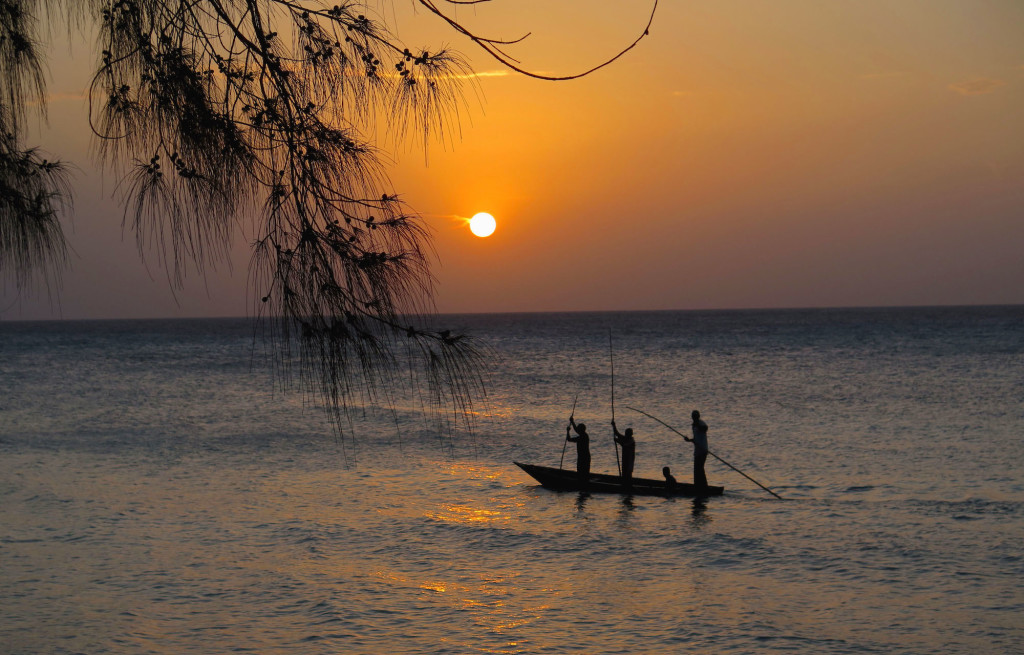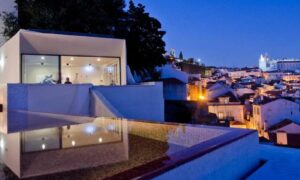(Editor’s note: No, Pemba Island isn’t in Europe, but it’s an exotic destination relatively easy to get to for Europe-based expats. See the post for more travel details.)
BY MIKE EGGERS
What makes you go back to a place time and time again?
Is it the location, the climate, experiences or the people? Places are special in their own right whether it’s their natural beauty or manmade magnificence. A sunny and warm environment is always enjoyable. Swimming, diving and/or kayaking in turquoise blue waters and seeing amazing sea life never gets old. But it’s sharing these times with friends that really make it worthwhile.
Raf and Cisca Jah, the owners of Swahili Divers, make it so to me and so many others. I’ve been visiting here since December of 2006 when I came to learn how to dive and had the good fortune of having Raf as my instructor. I’ve been coming back every year since. The rest – they say – is history.
Getting to Pemba Island isn’t easy, but most special places aren’t; part of the adventure is getting to them. In this case, most people fly into Dar es Salaam (DAR), Tanzania then take a local flight to Zanzibar and onward to Pemba Island.
Upon landing on Pemba Island the pre-arranged taxi (through Swahili Divers) gathers you and your bags and begins the 90-minute drive to Swahili Divers resort on the north end of the island. Along the way you drive through Chake Chake, the main town, and quickly enter the more rural area. Farm fields, clove groves, small villages, and scattered cows and calves and occasional goats alongside the road keep your interest.
School kids in their uniforms are heading home from school; pickup soccer games on chewed up fields provide some entertainment. Shade from the palm trees help cut down on the intense sunshine. The farther north you drive, the rougher the road becomes; it does smooth out on a sandy track as you drive through the Ngezi Forest Reserve where flying foxes and vervet monkeys live. Once through the Reserve you turn off the main road onto a track that leads to shore and Swahili Divers.
After passing through the gate the thatched roofs of the bungalows and other buildings appear and you’re there.
The setup of the resort is to blend in with the local surroundings and be as environmentally friendly as possible. The bungalows are built from coral blocks quarried on the island and covered with Palm tree fronds. The windows are covered with wooden lattice to allow the ocean breeze to drift through.
The bungalows are divided into two large rooms with raised coral block bed platforms covered with a mosquito netting. The bathroom has a gravity-fed shower from the connected water tank. Water is delivered by cattle cart in a large plastic tank in the wooden wagon. There is a ceiling fan in your room to help keep you cool. The power is provided by a generator that runs between 1800-0400 each day – that’s when the ceiling fan is operational.
The dining room, lounge, beverage counter and kitchen are under a large open-walled thatched roof building. The meals are fresh and delicious, cooked on charcoal burners as it has been done on Pemba for hundreds of years. Sometimes we picked up a just caught fish from a local fisherman on the way back from a dive and it would be cooked for our dinner.
A large wooden deck overlooks the waters of the Indian Ocean that flow between Pemba Island and the continent of Africa about 30 miles away. So, this is the environment I was ready to relax in, again, at the start of my tenth year of coming to Swahili Divers – yes, it’s a rough life.
After a day of getting used to the new time zone, I was ready to start diving. A group of us went out to Swiss Reef, a dive site north of the resort. It consists of a series of ridges and sometimes some strong currents; fortunately, today the waters were calm and we dived one of the shore ridges. We saw a lot of the “usual suspects,” sea life you constantly see around Pemba: puffer fish, goldies, anemone fish (aka Nemo’s family members), butterfly fish, trumpet fish, angel fish, and many others. This time around we were treated to a crocodile fish – yes its name accurately describes it, but it’s a much calmer creature.
On the way back after our dives we passed by a small building seemingly floating on the water. There was a roof-top deck as well lower deck just above the water with a pair of lounges. As we rode by you could make out a small sign “Guests Aboard.” This was the top of the $1,500-per-night underwater bedroom of the Manta Resort north of Swahili Divers! Guests are motored out and climb down a ladder to their room. Three sides are glass that provides you with a fantastic view of the underwater world.
At night, you can turn on outside lights that illuminate the amazing and colorful citizens of the Indian Ocean as they check you out. I think I’ll wait until they have a discount (a really big discount!) before booking the room.
Most of the dive sites around Pemba Island are within a 20-to-30-minute boat ride of the resort. These sites run the gauntlet of shallow coral reefs, large bommies, channel-drift dives, rows of ridges or sea walls that can drop hundreds of feet. Beautiful white fan coral, stunning yellow and beige colored table top coral, finger coral, whip coral and other coral join the massive fish population to overwhelm your senses. The coral and sea life are pristine, because this is a remote location and there is rarely any other dive group around – so you have your own private aquarium!
 You’ll see the local fishermen out in their hand-carved dugout canoes, small sailboats or some of the larger dhows when you’re out, on and in the water. They add to the island experience. Out of the water the island life keeps its hold on you: cooling off in the dive pool or the Indian Ocean, relaxing on the wooden deck overlooking the coastline, reading a book, listening to music or taking a nap. You could also watch the locals collect seaweed from their seaweed farms during low tide.
You’ll see the local fishermen out in their hand-carved dugout canoes, small sailboats or some of the larger dhows when you’re out, on and in the water. They add to the island experience. Out of the water the island life keeps its hold on you: cooling off in the dive pool or the Indian Ocean, relaxing on the wooden deck overlooking the coastline, reading a book, listening to music or taking a nap. You could also watch the locals collect seaweed from their seaweed farms during low tide.
 This started a few years ago and has been a wonderful money maker for these poor people. It is quite simple, drive wooden stakes into the coral, connect them with twine and let Mother Nature do the work.
This started a few years ago and has been a wonderful money maker for these poor people. It is quite simple, drive wooden stakes into the coral, connect them with twine and let Mother Nature do the work.
The seaweed gets caught by the twine as the tide comes in and out, and the locals collect it and dry it out. It is mostly women and children who do the collecting. So with their colorful clothes and the azure-sky-royal blue waters you have a kaleidoscope of colors. Then as sunset approaches, the sky and clouds put on their own show of yellow-orange-red hues with shades of blue that flow to black as the sun sinks into the African Continent.
Yes, very relaxing.
If you want to take a break from the diving, Swahili Divers offers snorkeling, sea kayaks, a mangrove kayak tour and can arrange tours to the spice and fish markets, the Ngezi Forest Reserve and the iron lighthouse the British built in 1901. If you don’t have your own dive gear it is available for rent. If you want to learn how to dive or take additional diving classes, that is easily coordinated. Wifi is available when the generator is running; but who wants the outside world intruding on your holiday?
Like all good things, this too came to end and it was time for me to move on and continue my sojourn. Since Turkish Airlines only has one flight a day into and out of DAR you have to fly from Pemba to Dar the afternoon before your 0400 flight to Istanbul. At least you don’t have to worry about the traffic to the airport.
So, give yourself a treat and enjoy a part of Africa you didn’t know was there.
Turkish Airlines has daily flights out of Istanbul to DAR; and from there Coastal Airlines or ZanAir have afternoon flights that can get you to Pemba. All these flights go to Pemba via Zanzibar and depart from the Domestic Terminal, which is a very short taxi ride away.
Flying Turkish Airlines to DAR gets you there at 0300. If your connecting flight is in the afternoon you can stay overnight in a hotel in downtown Dar es Salaam. When you arrive in the early hours of the morning you can get from the airport to your hotel in about 20-30 minutes. However, later that morning when you head back to the airport to catch your early afternoon flight to Pemba, it can take you up to two hours! The traffic is insane. A six-lane road, three in each direction, is turned into a quagmire of cars, trucks, buses, scooters, and cattle-drawn wagons trying to go in the same direction.
Traffic lights are sort of observed; traffic cops do their best. Otherwise it is a free-for-all. A better option is to stay at the transient motels near the airport with clean and safe rooms with air conditioning and transportation from and to the airport. Trinity Airport Hotel has been found satisfactory and reliable. This hotel and others can also be found on Bookings.com.
Trinity does offer meals at an additional cost.
About the author: Mike Eggers is a retired officer who took the Army up on its offer to see the world. Now an inveterate traveler and photographer, Mike is currently diving in Borneo with friends. Mike has lived in Turkey, Germany, and South Korea, and travels frequently to exotic and out-of-the-way destinations.


















